
Hong Kong is a world renown travel destination that needs no formal introduction. Located to the south of Mainland China, Hong Kong (hoeng gong, 香港) is a Special Administrative Region of China, and home to a unique blend of Cantonese and British cultures as a result of being under British colonial rule. Hong Kong is known as one of the Four Asian Tigers, in terms of economy, financial and tourism with its metropolitan food, culture and way of life. With the increasing interest of ‘going local’, tourists today want to do what locals do, which we will explore in terms of attractions that are unique and rare ranging from contemporary art to historical attractions.
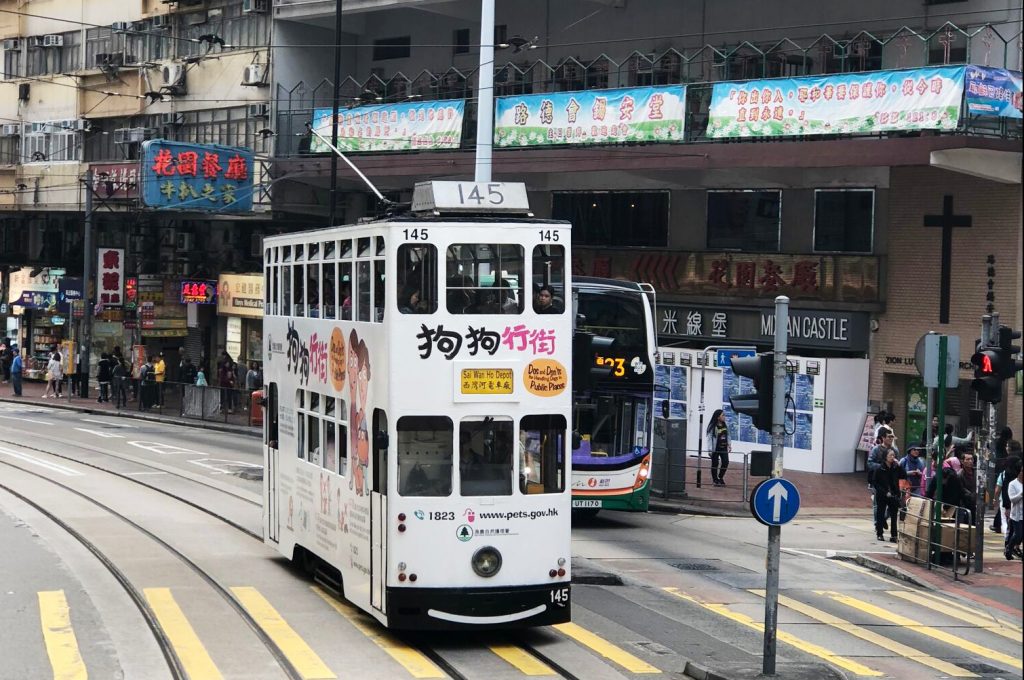
Hong Kong Culture
With a cross culture of modernity and traditional, Hong Kong is home to the Cantonese Chinese people who migrated south from Guangzhou, China. The people have developed their own idiosyncratic language and food that has diverged from traditional Cantonese culture. Under the British colonisation period, Hong Kong has evolved to birthing a unique language, cuisine and culture which is far different from its mainland counterparts. The Hong Kong Tourism Board has worked with various institutions to promote some of the lesser known hidden gems to show case the interesting evolution of Hong Kong society. With such a mix of east meets west, Hong Kong definitely has much to offer for both luxury living and affordable experiences.

Useful Cantonese Phrases in Hong Kong
The language used in Hong Kong is considered a Cantonese dialect (hoeng gong jyut jyu, 香港粵語), a variation of Guangdong Cantonese (gwong dung waa, 廣東話), which comes from a greater language family known as the Yue language (jyut jyu, 粵語). Hong Kong Cantonese is also colloquially called Hong Kongnese and can differ quite a bit from Guangdong Cantonese. This is because the language evolved to include many English loan words which are transliterated into Cantonese. For example, the Hong Kong Cantonese word taxi is dik si (的士) in Hong Kong Cantonese, a transliteration of the English word, whereas in Guangdong Cantonese, it is called ceot zou ce (出租車), meaning a private hire car. Here are some useful phrases to know when visiting Hong Kong.
English To Cantonese
Hello = nei hou maa (你好嗎)
Goodbye = zoi gin (再見)
Yes = hai (係)
No = m hai (唔係)
How much? = gei do cin? (幾多錢)
Cheaper please = peng dit m goi (平啲唔該)
Do you know… = nei sik m sik (你識唔識)
Is it far away? = jyun m jyun? (遠唔遠)
Delicious = hou sik (好食)
Thank you (for services rendered) = m goi (唔該)
Thank you (for receiving gifts) = do ze (多謝)
What To Eat In Hong Kong
When it comes to Hong Kong food there is a plethora of different cuisines, with Cantonese Cuisine being the predominant culture. However, much of Hong Kong cuisine is also heavily influenced by other traditional southern Chinese cuisines like Hakka (haak gaa, 客家), Fujian (fuk gin, 福建) and Teochew (ciu zau, 潮州). Today, northern Chinese cuisines such as Beijing (bak ging, 北京) and Szechuan (sei cyun, 四川) can be found throughout Hong Kong. Jiangnan (gong naam, 江南) cuisine encompassing cultures that lie south of the Yangtze River (joeng zi gong, 揚子江) including Shanghai (soeng hoi, 上海), Hang Zhou (hong zau, 杭州) and many other southern provinces can also be seen everywhere. As with its rich colonial history, British cuisine and other European cuisines have also left their marks. South East Asian cuisine has had its impact from the colonial trade routes.
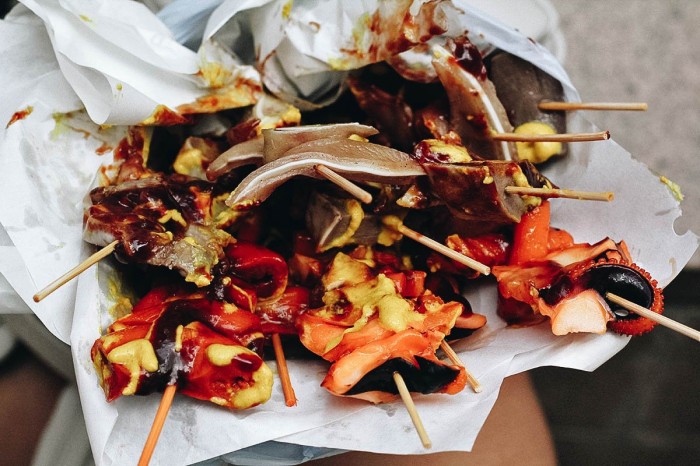
Image courtesy of tripzilla.com
Hong Kong Street Food Hawkers / Small Eats 小販
Hong Kong is famous for its street food called small eats (siu faan, 小販 or siu sik, 小食), and this would include hawker stalls that sell anything from grilled skewered meat to stinky tofu (cau dau fu, 臭豆腐). Small eats can come in the form of curry fish balls (gaa lei jyu daan, 咖喱魚蛋), pork dumplings (siu maai, 燒賣), imitation shark fin soup (wun zai chi, 碗仔翅), and egg waffles (gaai daan zai, 雞蛋仔), just to name a few. Small eats are usually bite sized foods that you can take away or eat as you walk. Some places to try would include having fried intestines (zaa daai coeng, 炸大腸) on Fa Yuen Road in Mongkok, as well as soy braised squid (lou seoi mak jyu, 鹵水墨魚) and duck gizzard (aap san, 鴨腎) at Fat Boy Shop (fei zai siu hek dim, 肥仔小吃店) in Sham Shui Po, a Michelin star street eat.
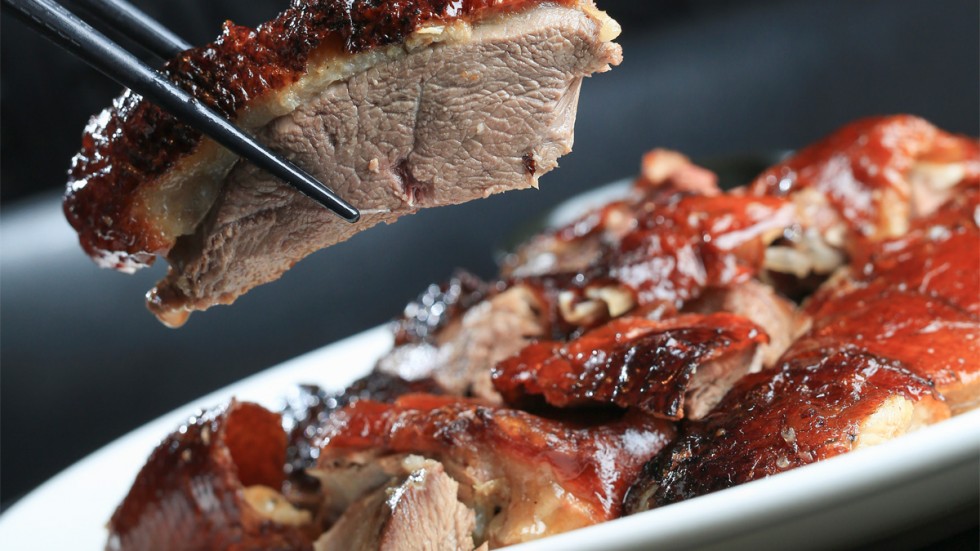
Image courtesy of scmp.com
Siu Laap 燒臘
Hong Kong is also famous for its roast meats which is a traditional Cantonese cooking style. Siu Laap (siu laap, 燒臘) consists of roast (siu mei, 燒味), braised (lou mei, 滷味), Chinese sausage (laap ceung, 臘腸), and white cut chicken (baak cit gai, 白切雞). The name Siu Laap comes from a combination of roasted (siu, 燒) and preserved (laap, 臘), referring to the general meat types served. Roast meats are usually seasoned with a variety of Chinese spices and soy sauce before roasting, but may involve further steps depending on the dish. Famous roast meats include roast duck (siu aap, 燒鴨), roast goose (siu ngo, 燒鴨), roast pork (siu juk, 燒肉), roast pigeon (siu jyu gap, 燒乳鴿) and barbecue pork (caa siu, 叉燒). Braised meats are braised in soy and spices and can consist of braised chicken (si jau gai, 豉油雞), braised duck (lou sui aap, 滷水鴨), braised cuttlefish (lou seoi mak jyu, 鹵水墨魚) and braised intestines (lou coeng, 鹵腸). Although white cut chicken (baak cit gai, 白切雞) is neither roasted nor braised, it is consider a Siu Laap. A famous restaurant for roast goose would be Yung Kee (鏞記) in Central.
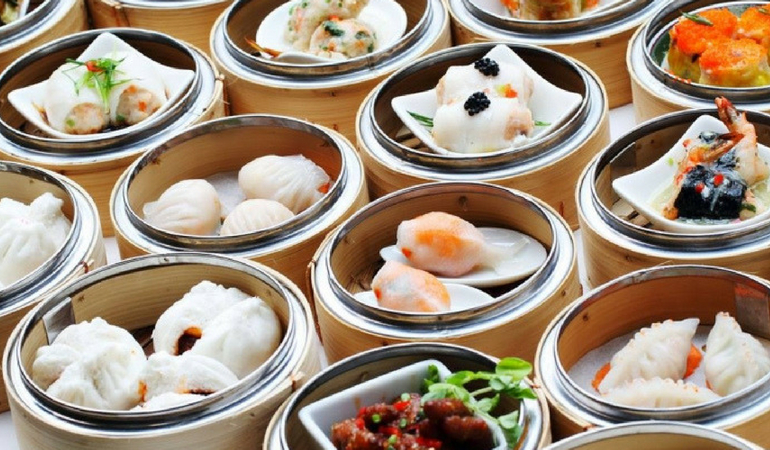
Image courtesy of dimsumcentral.com
Yum Cha 飲茶 / Dim Sum 點心
Yum Cha literally means “drink tea” but more accurately reflects the meal of having tea with dim sum. Dim Sum (dim sam, 點心) comes from the meaning “to touch the heart” and is reflected in the delicate nature of this cooking style. To put it simply, you will always have dim sum at a yum cha, but not every dim sum meal is considered yum cha, for example, if you have siu mai take away, as the drinking tea element is missing. Dim sum is usually served in bamboo steamers and small plates and may come steamed, pan fried or deep fried. There are really hundreds of varieties of dim sum depending on the chef and restaurant. The four dishes which are said to be used to test a dim sum chef’s skill would be the quality of their prawn dumplings (haa gaau, 蝦餃), pork dumplings (siu maai, 燒賣), pork buns (caa siu baau, 叉燒包) and glutinous rice (no mai gai, 糯米雞). Some other famous dim sum dishes would include congee (zuk, 粥), rice noodle rolls (coeng fan, 腸粉) and egg tarts (daan taat, 蛋撻), which are also considered famous dim sum dishes. A famous yum cha place would include YUM CHA in Central and Tim Ho Wan (添好運) in Sham Shui Po, the most affordable Michelin starred dim sum restaurant in Hong Kong.
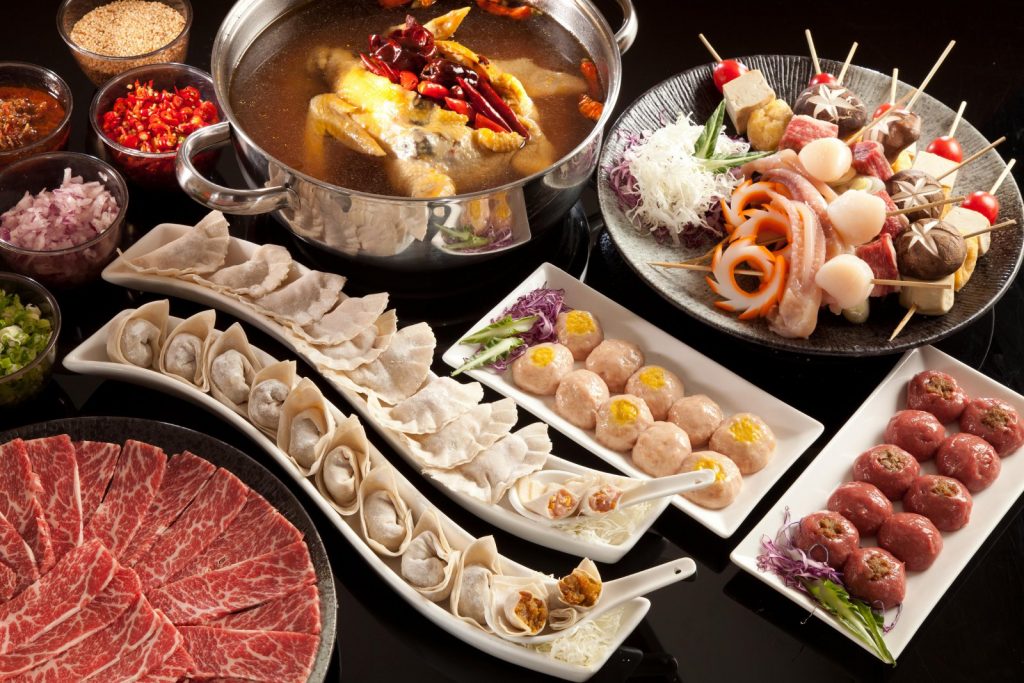
Image courtesy of sassyhongkong.com
Hot Pot 火鍋 / Daa Bin Lou 打邊爐
Hot Pot refers to a cooking method, where you cook your own meal in a hot pot. In Cantonese, the name daa bin lou (打邊爐) comes from the action of “hitting the side of the pot”, an action you do while you wait for your food to cook. This dish is also more accurately known as a hot pot (fo wo, 火鍋). The dish usually consist of a soup base including a selection of pork bone, Szechuan Mala (sei cyun maa laat, 四川麻辣), seafood, herbal chicken and plethora of variation. Usually thinly sliced beef, pork and chicken are the main protein, with a wide selection of seafood and meat and fish balls to choose from. Most hot pot restaurants also offer a selection of different condiments and sauces for you to customise from. Some famous hot pot places would include Megan’s Kitchen in Waan Chai.
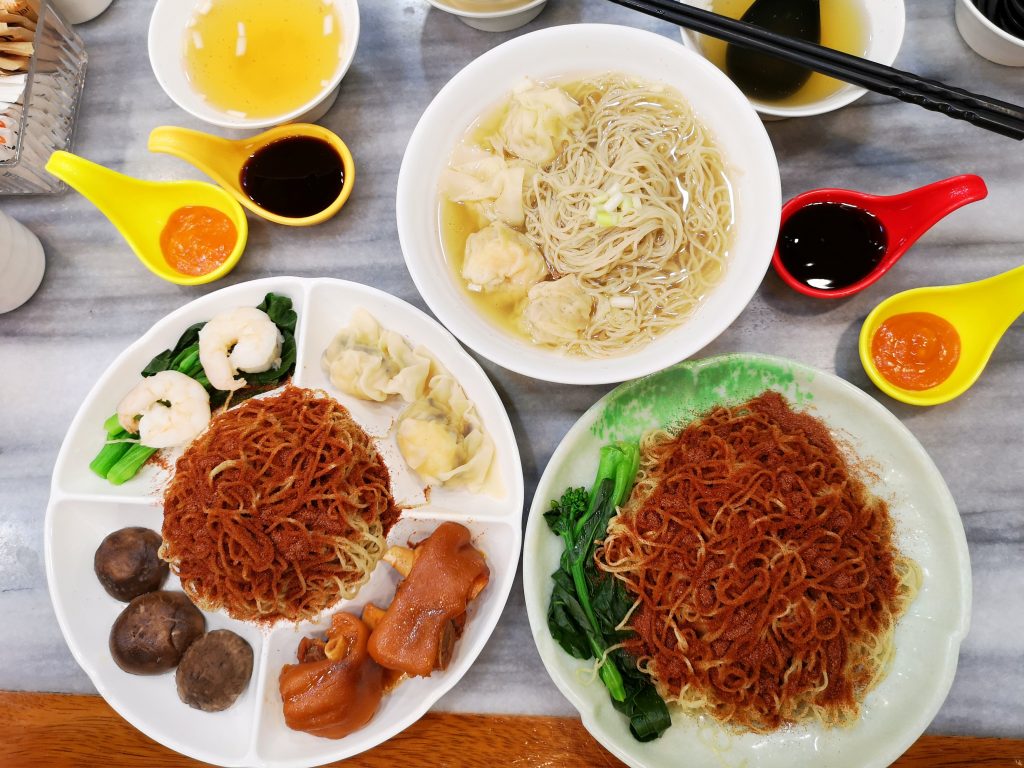
Image courtesy of Panda Phoon
Dai Pai Dong 大排檔
Dai Pai Dong (daai paai dong, 大排檔) are small hawker type restaurants by the street. The name Dai Pai Dong comes from Cantonese word “big licence” referring to the larger sized special license. There are many open air roadside stalls that are also erroneously called Dai Pai Dong but do not carry that specific licence. Dai Pai Dong may serve anything from rice plates (dip tau fan, 碟頭飯), noodles, congee or desserts. This is considered a dying culture as they constantly face closure with the escalating of rental cost as well as younger generations being unwilling to take over. Although Dai Pai Dong has come to mean any eatery that operates roadside and open air, only 25 are officially left with that specific licence in Hong Kong today. Do not underestimate the small shops as some of them have acquired Michelin stars in their own right including bamboo noodles from Kwan Kee Bamboo Noodle (kwan gei zuk sing min, 坤記竹昇麵) in Cheung Sha Wan, doggie noodles at Block 18 Doggie’s Noodle (sap baat zo gau zai fan, 十八座狗仔粉) and steamed rice rolls at Hop Yik Tai (hap jik taai siu sik, 合益泰小食) in Sham Shui Po.
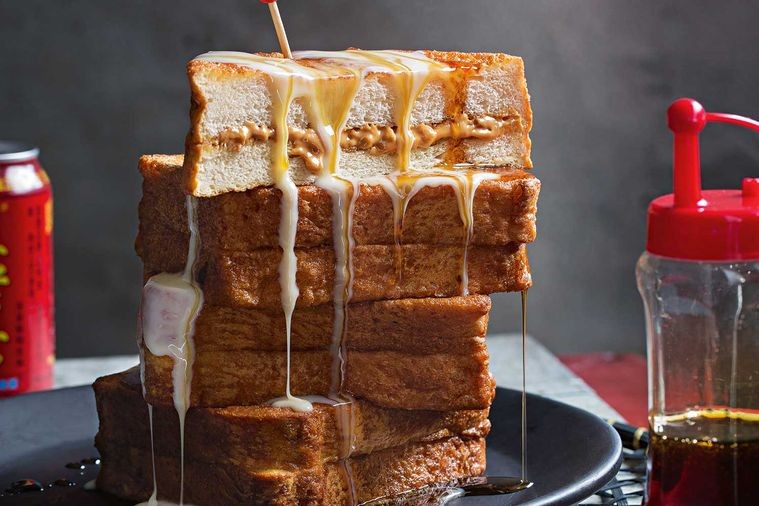
Image courtesy of delicious.com.au
Cha Chaan Teng 茶餐廳
Cha Chaan Teng (caa caan teng, 茶餐廳) are casual dining restaurants that serve Chinese cuisine (zung caan, 中餐) and Hong Kong style Western cuisine (sai chaan, 西餐). The name comes from restaurants trying to distinguish themselves from a western style restaurant (caan teng, 餐廳) by serving tea (cha, 茶) which gives it its name. These tea-restaurants serve a variety of food including Hong Kong-style French toast (sai do si, 西多士), pork chop rice (guk zyu paa faan, 焗豬扒飯), dessert soup (tong sui, 糖水), sago soup (sai mai lou, 西米露) and milk tea. A famous Cha Caan Teng would be Tsui Wah Restaurant (ceoi waa caan teng, 翠華餐廳) located in Lan Kwai Fong in Central.
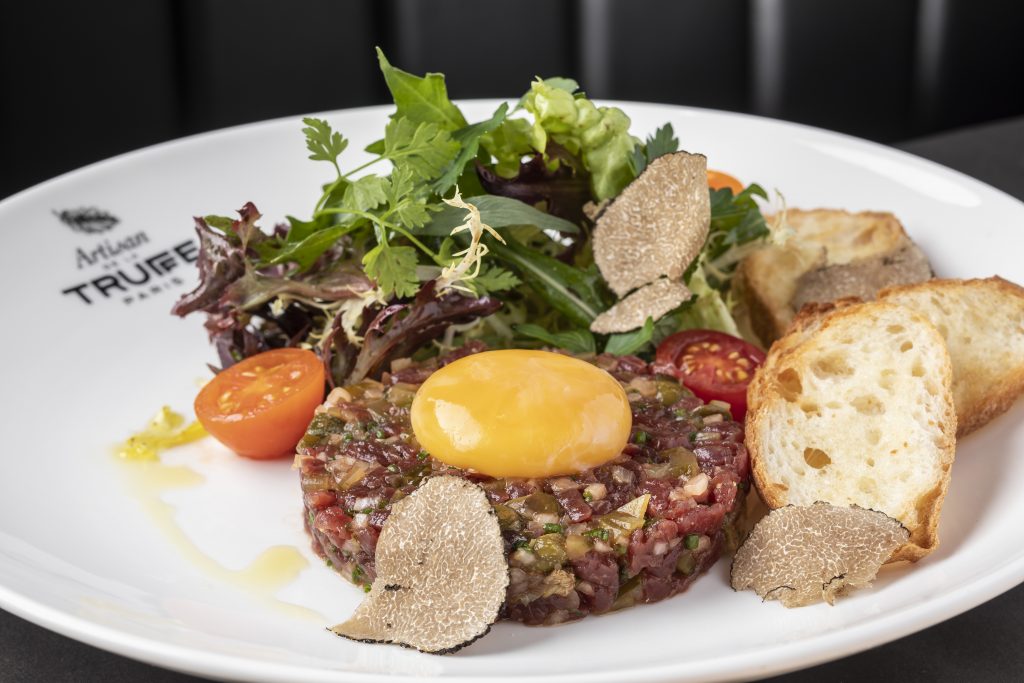
Image courtesy of Artisan de la Truffe
Fine Dining
Hong Kong is one of those countries where you can get great imported ingredients, and this can be seen with the number of high quality fine dining restaurants about. French, Italian, Japanese and Continental European cuisine is readily available anywhere you go. One such stand out would be the newly opened Artisan de la Truffe Hong Kong serving truffle with every single dish, including dessert.
What To Do In Hong Kong
There are many interesting sights and sounds in Hong Kong ensuring that there will always be something for everyone. In the day, there are many traditional tourist hot spots like Ocean Park and Victoria Peak, but for the avid traveller looking for more interesting experiences can dive into the local markets at Sham Shui Po and Mongkok. For those looking for something more cultural, the many museums and contemporary art scene around Central is also a good choice. For travellers looking to get back to nature, Lamma Island (lam aa dou, 南丫島) and Lantau Island (daai jyu saan, 大嶼山) are a boat’s ride away.
Central 中環
Central is known as zung wan (中環) and is the “downtown” of Hong Kong. Located on Hong Kong Island (hoeng gong dou, 香港島), Central is considered the financial hub of Hong Kong and is also home to many upscale restaurants and bars. The revitalised Tai Kwun (daai gun, 大館) is also located here, which was the former Central Police Station, Central Magistracy and Victoria Prison. This revitalised hub today is known as the Tai Kwun Centre of Heritage & Arts (大館歷史藝術集合). The Victoria Prison, where Ho Chi Minh once served a sentence, functions as a museum today while the new JC Contemporary, designed by Herzog & de Meuron, houses an art exhibition preserving contemporary art and culture in Hong Kong. The Old Bailey restaurant and bar serving Jiangnan cuisine can also be found here. Around the corner on Hollywood Road also sits some of Hong Kong’s best bars including the Quinary and The Old Man nearby. Jimmy’s Kitchen, one of Hong Kong’s oldest restaurant that served British Hong Kong Colonial cuisine can be found in Central as well.
For our review of Jimmy’s Kitchen, see Jimmy’s Kitchen Hong Kong.
For our review of Quinary, see Quinary Hong Kong.
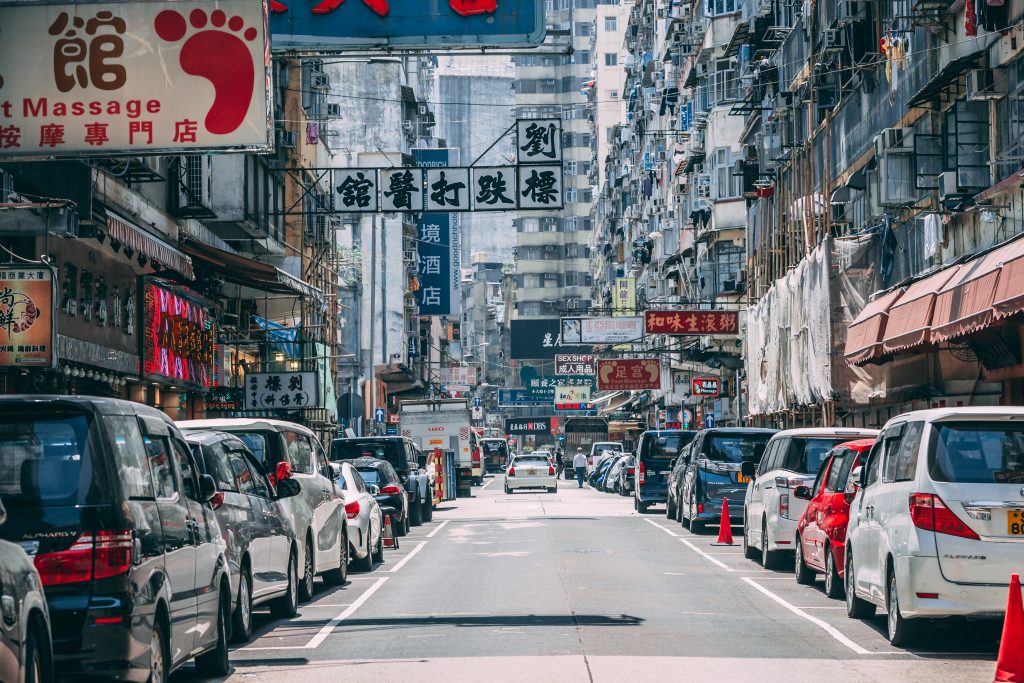
Sham Shui Po 深水埗
Sham Shui Po (sam seoi bou, 深水埗) is located on the mainland of Kowloon (gau lung, 九龍), a predominantly working-class district and is the perfect place for a cheap and exciting experience. Sham Shui Po comes from the Cantonese word “deep water pier” and is a location that offers a wide selection of street food because of its predominant working-class. However, in recent years this area has become a tourist attraction for travellers looking for a more local and authentic experience. Ki Lung Street is famous for its fabric market, and Tim Ho Wan, famous for having the cheapest Michelin star restaurant in Hong Kong. Other famous eateries in the area include the tofu pudding (dau fu faa, 豆腐花) at Kung Wo Beancurd Factory, doggie noodles (gau zai fun, 狗仔粉) at Block 18 Doggie’s Noodle, rice noodle rolls (coeng fun, 腸粉) at Hop Yik Tai (合益泰小食) and egg waffles (gai dan zai, 雞蛋仔) at Mammy Pancake.
Tsim Sha Tsui 尖沙咀
Tsim Sha Tsui comes from the Chinese name “sharp sandpit (zim saa zeoi,尖沙咀)”, and is situated on mainland Kowloon. Abbreviated to TST, this place is considered an important commercial and financial hub in Hong Kong. Tsim Sha Tsui is famed for its shopping streets and many high-end harbour front dining and bars. Famous shopping international name brands for Louis Vuitton to Gucci can be found along Canton Road. One of the oldest shopping centres in Hong Kong is Harbour City on Victoria Harbour which has recently expanded to include many new fine dining restaurants serving a variety of cuisine in its new Ocean Terminal Expansion. This location overlooks both Kowloon and Hong Kong Island’s harbour front and is a magnificent place to experience Hong Kong in all its waterfront grandeur. Some highlighted experiences would include truffle centric dining at Artisan de la Truffe from France which overlooks the channel.
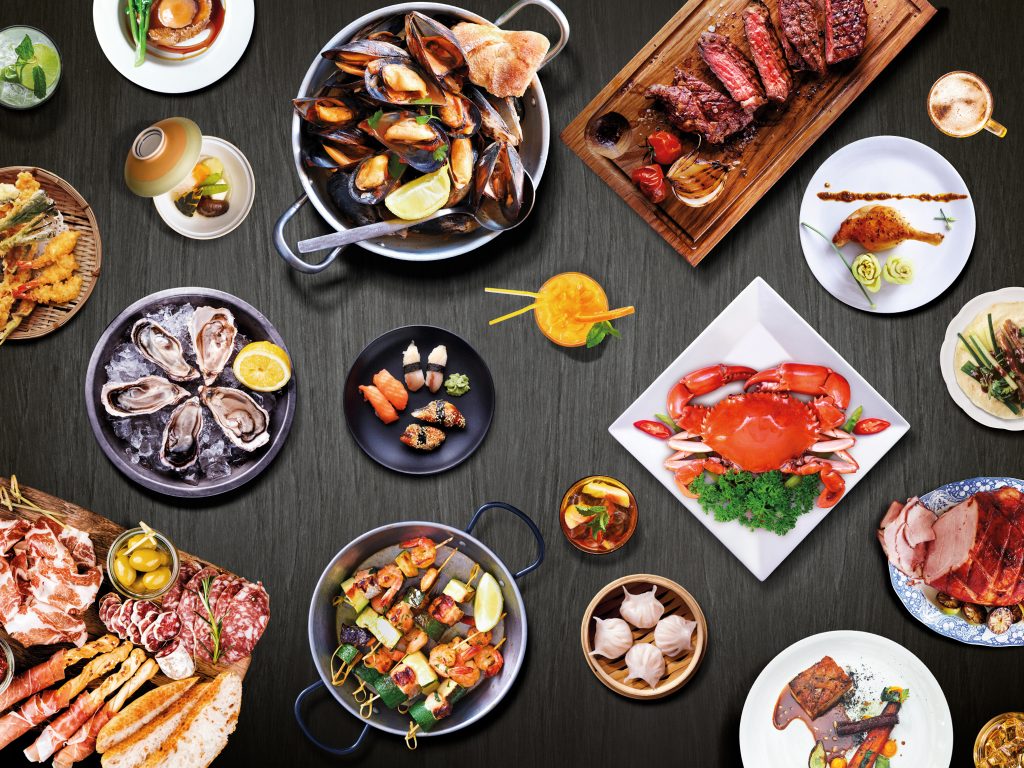
Great November Feast 香港盛宴11月
The Great November Feast is a month celebration organised by the Hong Kong Tourism Board to showcase Hong Kong’s culinary spectrum. The event sees the participation of some of Hong Kong’s best restaurants including Old Bailey in Tai Kwun and Artisan de la Truffe at Harbour City. Harbour City is also one of the main sponsors of the event, with the Sunset Cheers Tasting Party where you can enjoy premium canned seafood paired with fine wines against the Victoria Harbour sea view with the Tasting Pass. 9 participating restaurants at Harbour City will also be having a Happy Sunset Hour serving food and wine pairing overlooking the sunset.
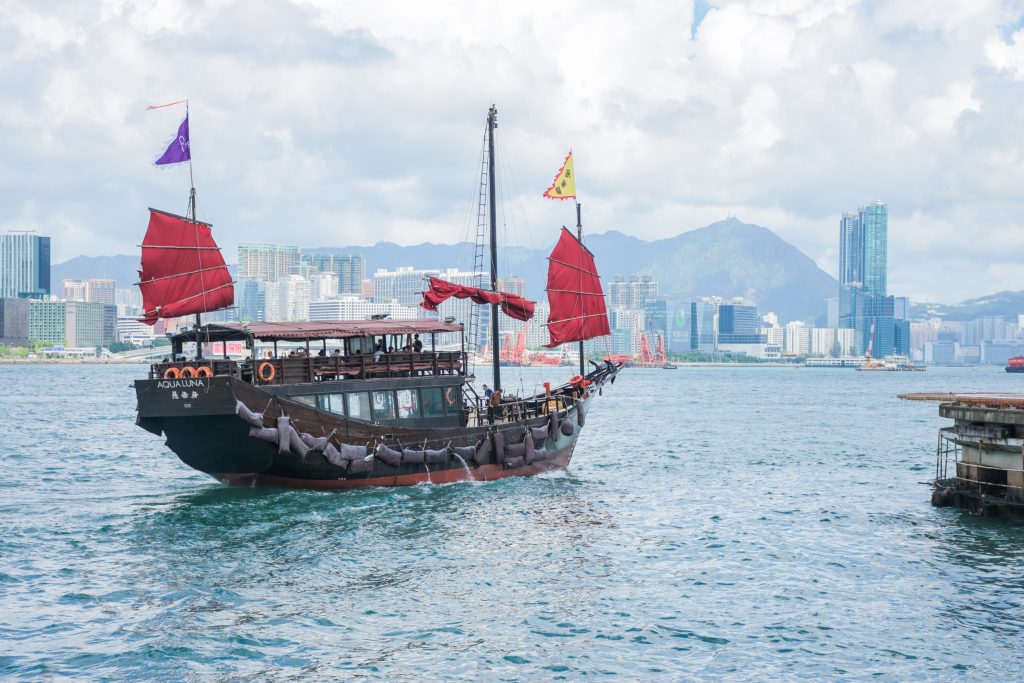
Aqua Luna 張保仔
Aqua Luna is a harbour cruise and is considered one of the last traditional red Chinese junk boats in Hong Kong. The ship’s name in Cantonese is Cheung Po Tsai (zoeng bou zai, 張保仔) and is named after the infamous Chinese pirate. The cruise has many variations from the Dim Sum Cruise (dim sum hong jau, 點心航遊) to the Symphony of Lights Dinner & Cruise (waan coi wing hoeng gong maan caan gap jau syun, 幻彩詠香江晚餐及遊船) which boasts a light and show at nights overviewing illuminating the harbour skyline. The night cruises include a great dancing light show that you really should not miss. Great to be enjoyed with a glass of wine overlooking the harbour.
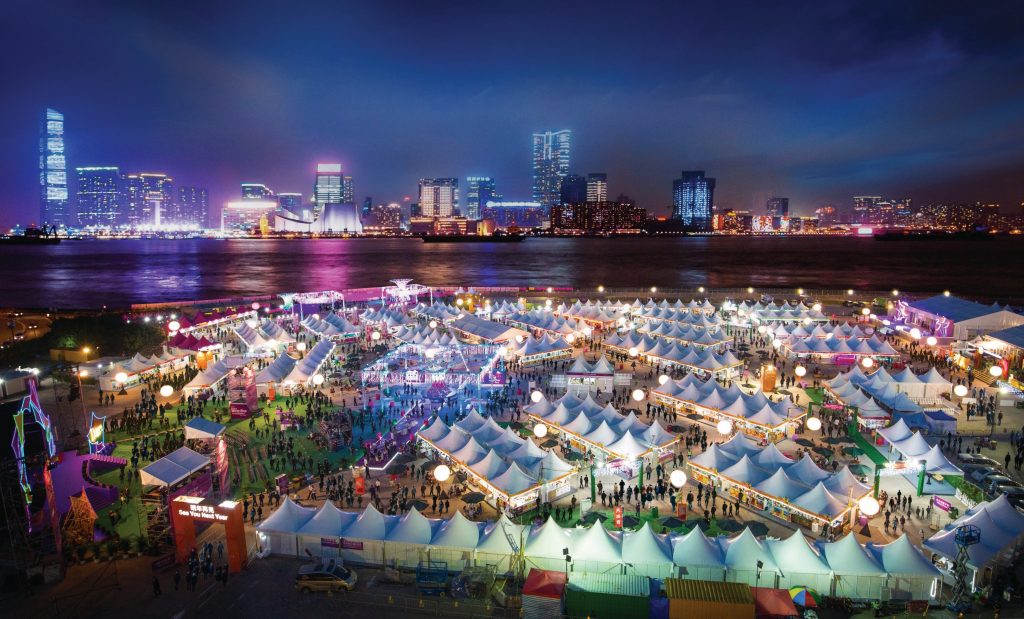
Hong Kong Wine and Dine Festival 香港美酒佳餚巡禮
The Hong Kong Wine and Dine Festival is an annual gourmet festival held by the Hong Kong Tourism Board with China Construction Bank which serves over 450 booths of fine wines and exquisite food from all over Hong Kong. With Michelin star chefs heading the line-up, a plethora of fine restaurants and hotels showcase different cuisines which are some of the best that Hong Kong has to offer. For the 10th year anniversary, party elements were also infused over the 4-day event bringing in local visitors and tourist from abroad to the largest ever wine and dine festival held.
For more information, see our experience at the Hong Kong Wine and Dine Festival 2018.
For Jackson Wang’s recommendations, see Jackson Wang’s Favourite Food in Hong Kong.
Where To Stay In Hong Kong
When it comes to stays, Hong Kong offers a wide range of hotels, from the more affordable youth hostels to a variety of luxury hotels located both in Kowloon and on Hong Kong Island. Some of the best hotels are the ones located on the harbour front, including Marco Polo Hong Kong Hotel and The Peninsula.
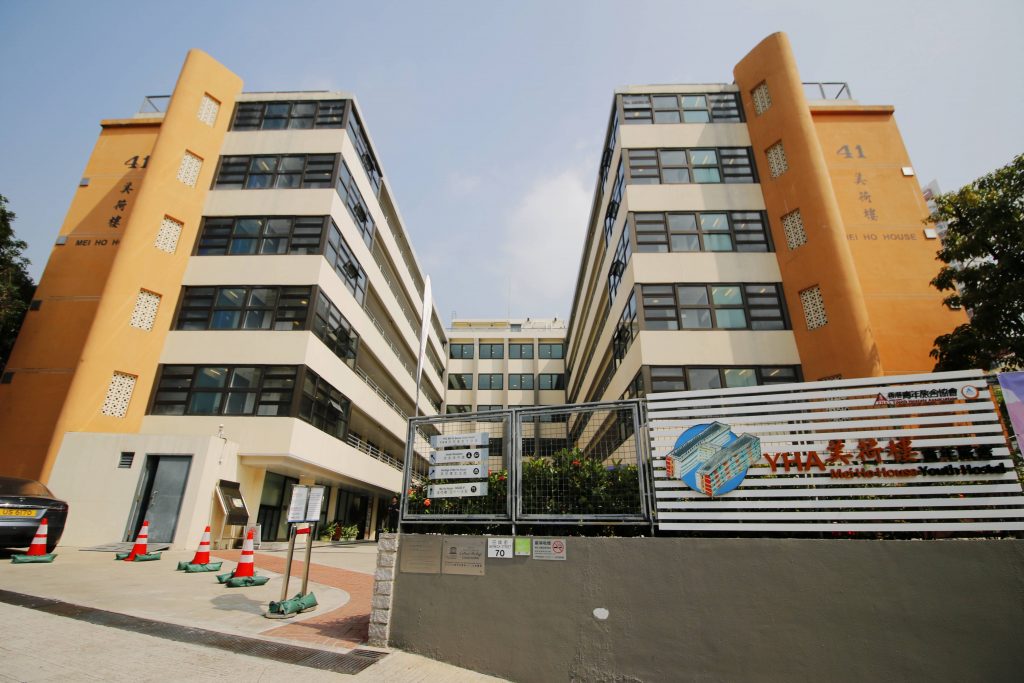
Mei Ho House Youth Hostel
Mei Ho House (mei ho lau, 美荷樓) was a government housing scheme that was built to relocate survivors from a fire disaster in 1953. The building is the only one out of the 29 blocks which were built that has been chosen to be preserved as a Grade 2 Historic Building, with the rest being torn down and built over. Today the building functions both as a youth hostel as well as a museum giving a historic account about the tragedy from the disaster and Hong Kong life in the 50’s.
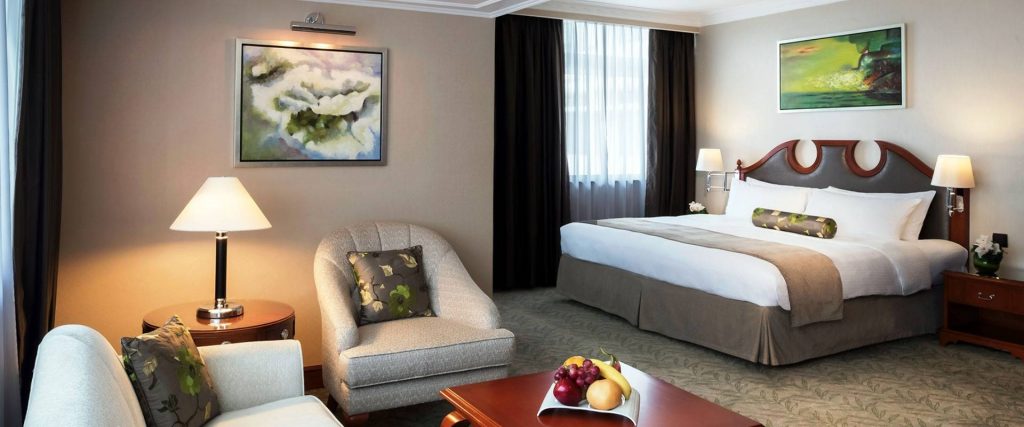
Marco Polo Hong Kong Hotel
Marco Polo Hong Kong Hotel is situated on Canton Road and is in the heart of Tsim Sha Tsui in Kowloon. This harbour front hotel is located in one of Hong Kong’s most famous shopping streets, with over 400 name brand and high street shops. This hotel is prime location, connected to the Harbour City shopping centre, as well as having the convenience of having an assortment of entertainment hubs within a stone’s throw.
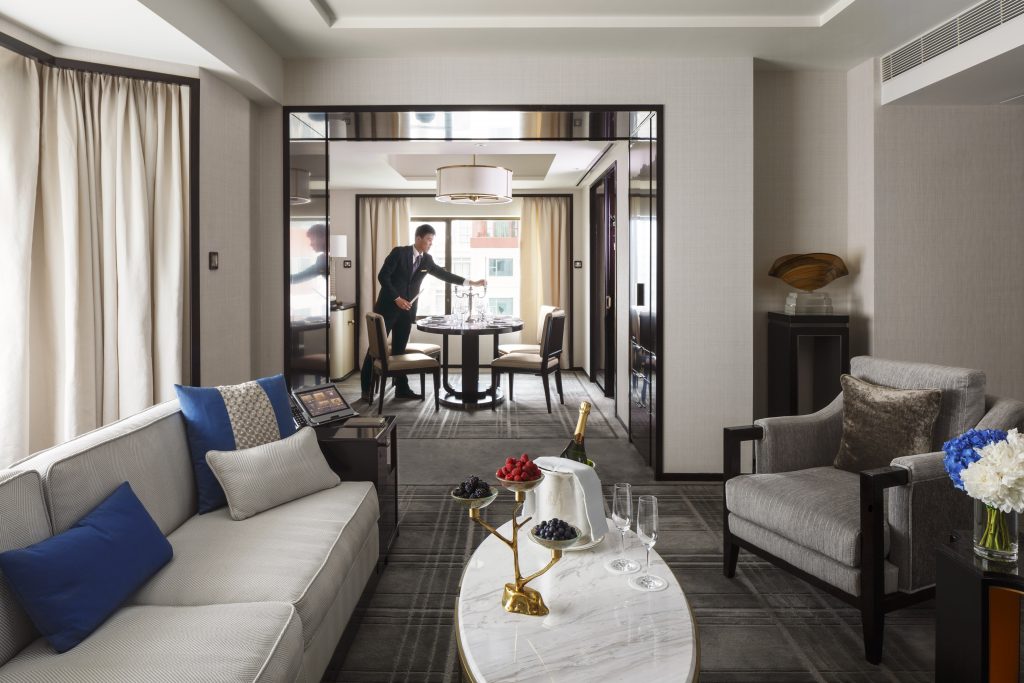
The Peninsula Hong Kong Hotel
The Peninsula is one of Hong Kong’s oldest colonial hotels, boasting a beautiful colonial aesthetics. The hotel is one of Hong Kong’s most renown locations and will definitely cater to all your needs. Located in Tsim Sha Tsui, the hotel is one of the most luxurious stays you can experience in Hong Kong.
Hong Kong is home to some of the best cuisine in the world, with its perfect blend of east meets west. From street food to fine dining, and street eats to drink culture, Hong Kong has it all. With so many little gems and local experiences, you can understand why it’s time to #DiscoverHongKong.
For our list of of Best Bars in Hong Kong, see our review of Best Bars in Hong Kong 2018.